Climate and Hydrological Change Characteristics and Applicability of GLDAS Data in the Yarlung Zangbo River Basin, China
Abstract
:1. Introduction
2. Objective, Study Area, Data and Methods
2.1. Objective
2.2. Study Area
2.3. Data
2.3.1. Observed Meteorological and Hydrological Data
2.3.2. Global Land Data Assimilation System (GLDAS)
2.4. Methods
2.4.1. Comparison and Applicability Analysis of Meteorological Data
2.4.2. Comparison and Applicability Analysis of Runoff Data
3. Results and Discussion
3.1. Characteristics of Observed Climate and Runoff Changes
3.1.1. Characteristics of Observed Precipitation Change during the Past 40 Years
3.1.2. Characteristics of Observed Temperature Change during the Past 40 Years
3.1.3. Characteristics of Observed Runoff Change during the Past 20 Years
3.2. Applicability Analysis of GLDAS Data
3.2.1. Applicability Analysis of GLDAS Precipitation Data
3.2.2. Applicability Analysis of GLDAS Temperature Data
3.2.3. Applicability Analysis of GLDAS Runoff Data
3.3. Impact of Climate Change on Runoff
4. Conclusions
- (1)
- Under the background of global warming, precipitation, temperature, and runoff changed significantly, and showed certain regularity during the research period. Based on the three time scales, we observed that mean monthly precipitation, temperature and runoff presented clear cyclical fluctuations of approximately 12 months. The highest secular mean monthly values occurred in July and August, and the lowest values occurred in December and January. The annual precipitation, temperature, and runoff trends showed slight increases during the study period. The maximum mean annual values occurred in 1998 and 1999, and the minimum mean annual values occurred in 1983. These analyses indicate that changes in precipitation, temperature, and runoff during the research period exhibited strong consistency.
- (2)
- A comparison of observed precipitation and temperature with GLDAS climate data indicated that the GLDAS data have good applicability in the midstream region of the Yarlung Zangbo River basin. The GLDAS mean monthly precipitation and temperature presented the same clear cyclical fluctuation as the observed climate values. The GLDAS mean monthly precipitation was moderately correlated with observed precipitation, with a correlation coefficient of 0.75. The GLDAS mean monthly temperature was highly correlated with observed temperature, with a correlation coefficient of 0.94. This shows that GLDAS temperature data can be used to reproduce observed temperature in the study period. However, the quality of precipitation data from July to August and of temperature data from November to February of the next year needs to be improved.
- (3)
- A comparison of observed and GLDAS-based runoff data indicated that runoff from the four GLDAS models had similar fluctuations and significant seasonal variability compared with observed runoff during the study period. All four datasets had similar change cycles of approximately 12 months compared with observed runoff for Nuxia gauging station, and runoff from the Yarlung Zangbo River basin increased slightly during the study period. However, the amplitudes of each GLDAS model were higher than those of observed runoff, and observed runoff occurred later than GLDAS-based runoff. The Brunke ranking method showed that the total ranking scores of the four GLDAS models were 2.75, 1.75, 2.50, and 3.00, respectively. Hence, it can be concluded that GLDAS-Noah-based runoff data are closer to observed runoff data for Nuxia gauging station compared with the three other GLDAS models.
- (4)
- Runoff from the Yarlung Zangbo River basin is strongly affected by climate change. Correlation coefficients between precipitation and runoff for the 3 time scales were higher than those between temperature and runoff. Secular mean monthly precipitation had the strongest relationship with runoff. This means that a change in precipitation is the most important factor that affects natural runoff changes in the midstream region of the Yarlung Zangbo River basin. Rainfall can control the evolution of the river to some degree.
Acknowledgments
Author Contributions
Conflicts of Interest
References
- Guo, J. Research on the Impact of Climate Change on Watershed Water Cycle and Water Resource; Wuhan University: Wuhan, China, 2010. [Google Scholar]
- IPCC (Intergovernmental Panel on Climate Change). Synthesis Report; Cambridge University Press: Cambridge, UK, 2001. [Google Scholar]
- IPCC (Intergovernmental Panel on Climate Change). Climate Change: The IPCC Impacts Assessment; AGPS Press: Canberra, Australia, 2001. [Google Scholar]
- IPCC (Intergovernmental Panel on Climate Change). Impacts, Adaptations and Mitigation of Climate Change: Scientific Technical Analyses; Cambridge University Press: Cambridge, UK, 1995. [Google Scholar]
- IPCC (Intergovernmental Panel on Climate Change). Synthesis Report; Cambridge University Press: Cambridge, UK, 2007. [Google Scholar]
- Animesh, K.G.; Gain, C.; Fabrice, G. Renaud Climate Change Adaptation and Vulnerability Assessment of Water Resources Systems in Developing Countries: A Generalized Framework and a Feasibility Study in Bangladesh. Water 2012, 4, 345–366. [Google Scholar] [CrossRef] [Green Version]
- Lisa, J.L.; Joel, D.G.; Vernon, L.S. Climate Change and Classic Maya Water Management. Water 2011, 3, 479–494. [Google Scholar] [CrossRef]
- National Research Council. Climate, Climate Change and Water Supply; National Academy Press: Washington, DC, USA, 1977. [Google Scholar]
- Dong, L.H.; Xiong, L.H.; Yu, K.X.; Li, S. Research advances in effects of climate change and human activities on hydrology. Adv. Water Sci. 2012, 23, 278–285. [Google Scholar]
- Zhao, X.S.; Zhou, H.; Wang, W.C. Research Progresses of Impacts of the Climate Change on the Regional Hydrological Cycle System. J. North China Inst. Water Conserv. Hydroelectr. Power 2012, 33, 46–49. [Google Scholar]
- Zhang, L.P.; Chen, X.F.; Zhao, Z.P.; Hu, Z. Progress in Study of Climate Change Impacts on Hydrology and Water Resources. Prog. Geogr. 2008, 27, 60–67. [Google Scholar]
- Wang, G.Q.; Zhang, J.Y.; Liu, J.F.; Li, Y.; He, R.M. Review of impacts of climate change on hydrology and water resources. Adv. Water Sci. 2008, 2, 47–51. [Google Scholar]
- Bai, L.Y.; Rong, Y.S. Impacts of climate on water resources in source regions of Yangtze River and Yellow River. Water Resour. Prot. 2012, 28, 46–50. [Google Scholar]
- Tang, F.F.; Xun, Z.X.; Zuo, D.P. Response of Runoff to Climate Change in the Upper Yellow River Basin. Resour. Sci. 2012, 34, 1079–1088. [Google Scholar]
- Wang, G.Q.; Li, M.; Jin, J.L.; Liu, C. Variation Trend of Runoff in Fujiang River Catchment and Its Responses to Climate Change. J. China Hydrol. 2012, 32, 22–28. [Google Scholar]
- Jiao, K.Q.; Ye, B.S.; Han, T.D.; Jin, Z.; Yang, H.A. Response of Runoff to Climate Change in the Glacier NO.1 at the Headwater of Urumpi River, Tianshan Mountains during 1980–2006. J. Glaciol. Geocryol. 2011, 33, 606–611. [Google Scholar]
- Li, X.; Gao, Y.H.; Wang, W.Z.; Lan, Y.; Xu, J.; Li, K. Climate changes and applicability of GLDAS in the headwater of the Yellow River Basin. Adv. Earth Sci. 2014, 29, 531–540. [Google Scholar]
- Nie, N.; Zhang, W.C.; Deng, C. Spatial and Temporal Climate Variations from 1978 to 2009 and their Trend Projection over the Yarlung Zangbo River Basin. J. Glaciol. Geocryol. 2012, 34, 64–71. [Google Scholar]
- Li, Z.L.; Xu, Z.X.; Gong, T.L. Characteristics of runoff variationin the Yarlung Zangbo River basin. Geogr. Res. 2008, 27, 353–361. [Google Scholar]
- Xu, P.K. Study on Glacier&Groundwater Mass Changes of Yarlung Zangbo River Basin in the Recent Years; Nanjing University: Nanjing, China, 2013. [Google Scholar]
- Fang, H.L.; Beaudoing, H.K.; Rodell, M.; Teng, W.; Vollmer, B.E. Global Land Data Assimilation System (GLDAS) products, services and application from NASA Hydrology Data and Information Services Center (HDISC). In Proceedings of the ASPRS 2009 Annual Conference, Baltimore, MD, USA, 1–9 March 2009. [Google Scholar]
- Wang, Y.J.; Wang, S.D.; Song, W.L.; Yang, S. Application of GLDAS data to the potential evapotranspiration monitoring in Weihe River Basin. J. Arid Land Resour. Environ. 2013, 27, 54–58. [Google Scholar]
- Rodell, M.; Houser, P.R.; Jambo, R.U.; Gottschalck, J.; Mitchell, K.; Meng, C.; Arsenault, K.; Cosgrove, B.; Radakovich, J.; Bosilovich, M.; et al. The global land data assimilation system. Bull. Am. Meteorol. Soc. 2004, 85, 381–394. [Google Scholar] [CrossRef]
- Wang, W.; Wang, X.J.; Wang, P. Assessing the applicability of GLDAS monthly precipitation data in China. Adv. Water Sci. 2014, 25, 769–778. [Google Scholar]
- Wang, X.J.; Wang, W.; Wang, P. Assessing Applicability of GLDAS Monthly Temperature Data in China. Water Res. Power 2014, 32, 10–14. [Google Scholar]
- Brunke, M.A.; Fairall, C.W.; Zeng, X.B.; Eymard, L.; Curry, J.A. Which bulk aerodynamic algorithms are least problematic incomputing ocean surface turbulent fluxes. J. Clim. 2003, 16, 619–635. [Google Scholar] [CrossRef]
- Wei, F.Y. Modern Climatic Statistical Diagnosis and Prediction Technology; Climate Press: London, UK, 2007; pp. 1–298. [Google Scholar]
- Liu, C.; Ye, Y.; Jie, J.; Zhou, X.; Li, J.L.; Ge, J. Applicability of Soil Temperature and Moisture in Several Datasets over Qinghai-Xizang Plateau. Meteorology 2015, 34, 653–665. [Google Scholar]
- Jiang, C.; Zhang, L.B.; Li, D.Q.; Li, F. Water Discharge and Sediment Load Changes in China: Change Patterns, Causes, and Implications. Water 2015, 7, 5849–5875. [Google Scholar] [CrossRef]
- Zhu, T.J.; Ringler, C. Climate Change Impacts on Water Availability and Use in the Limpopo River Basin. Water 2012, 4, 63–84. [Google Scholar] [CrossRef]
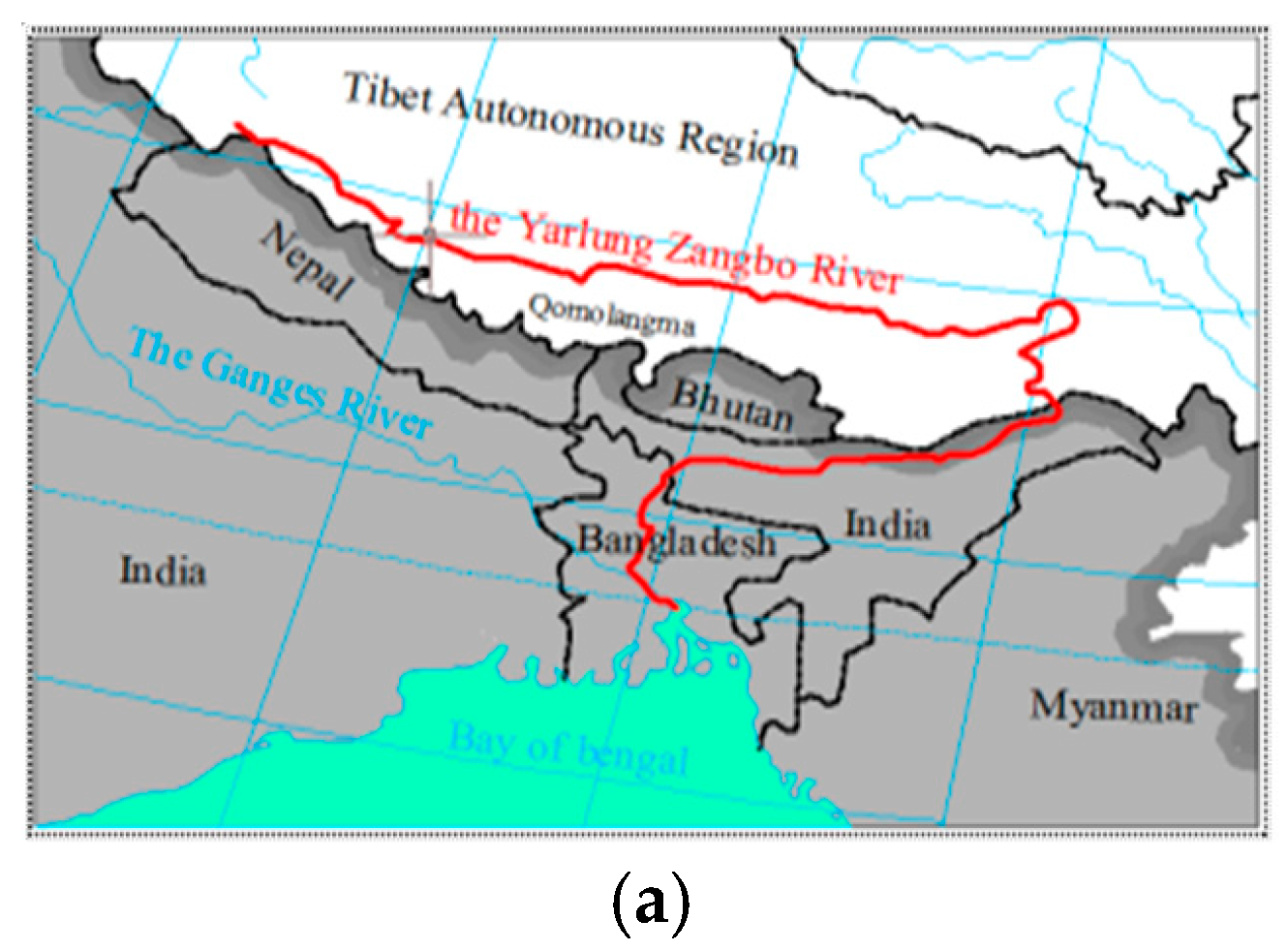
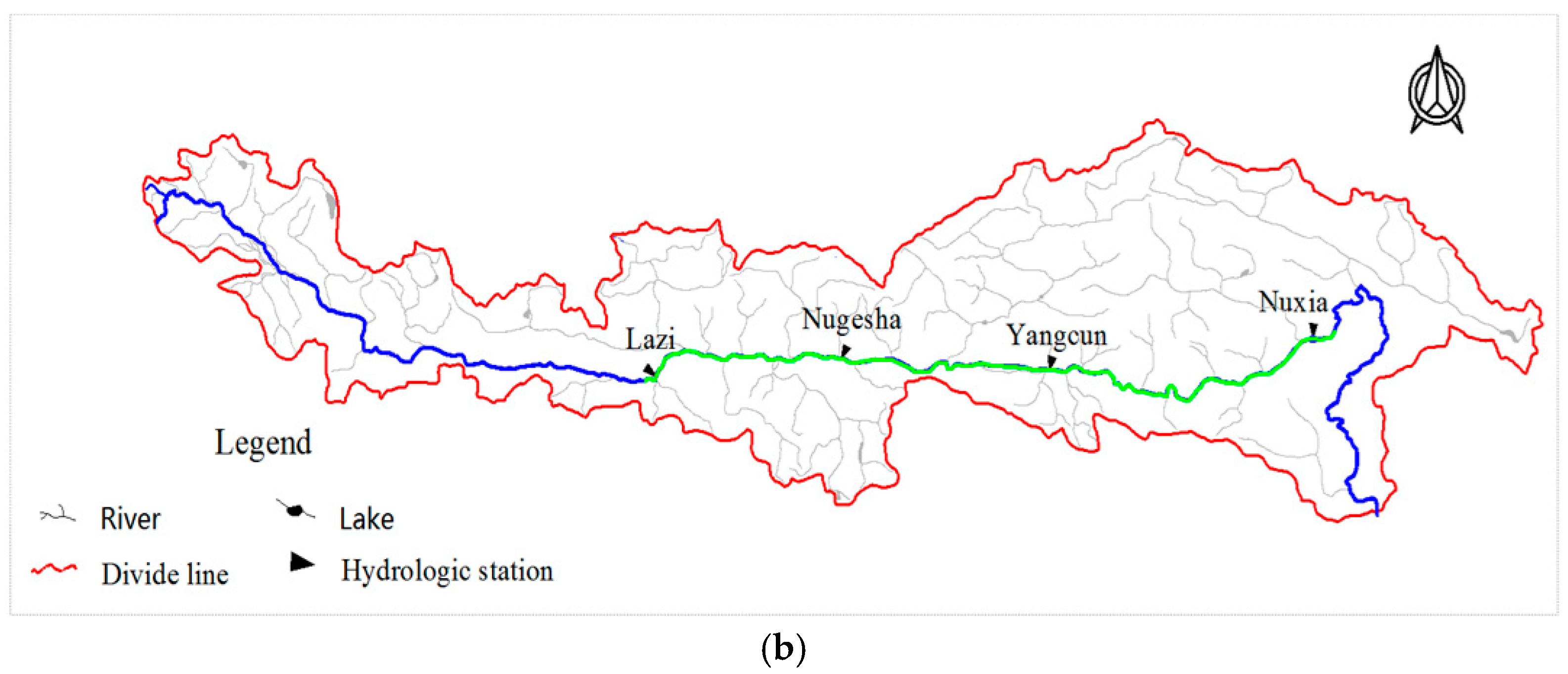
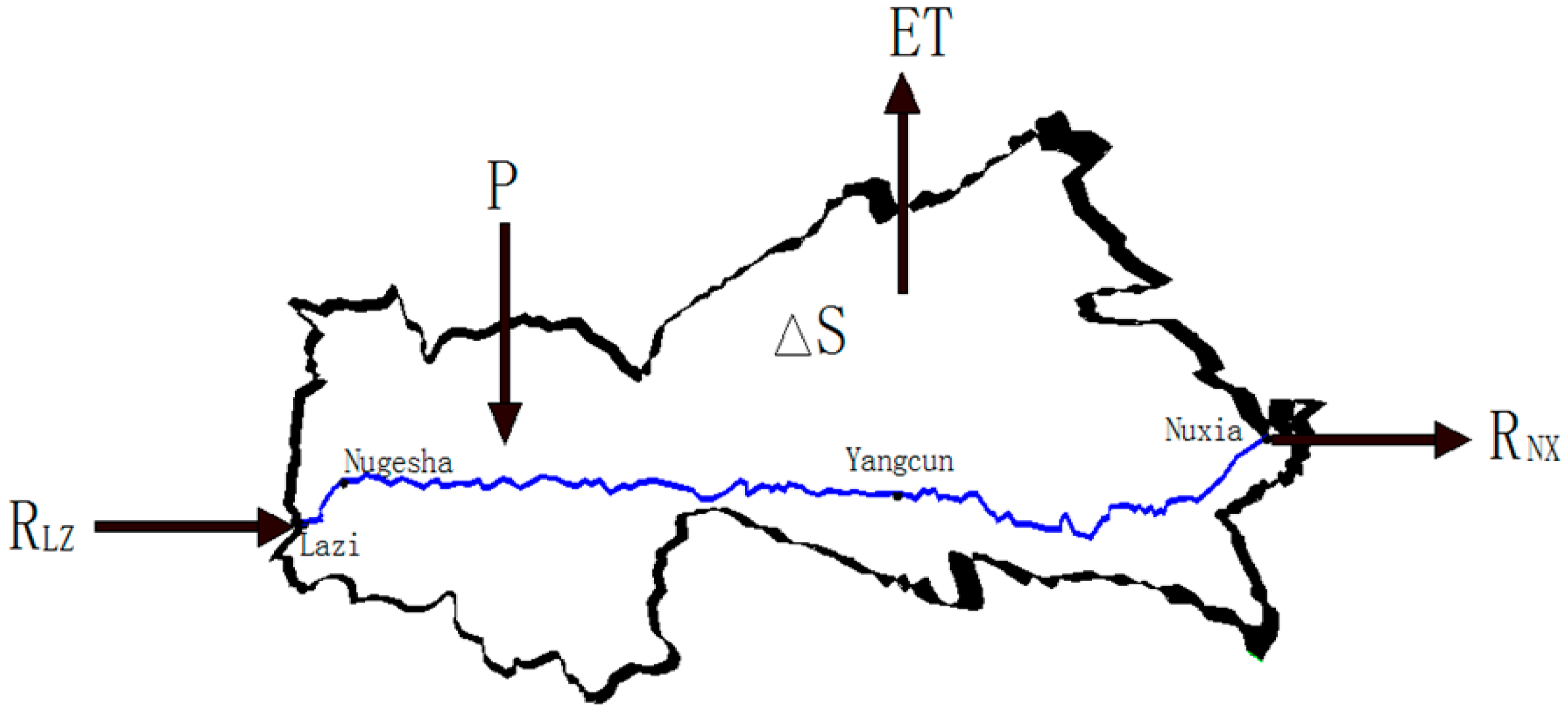

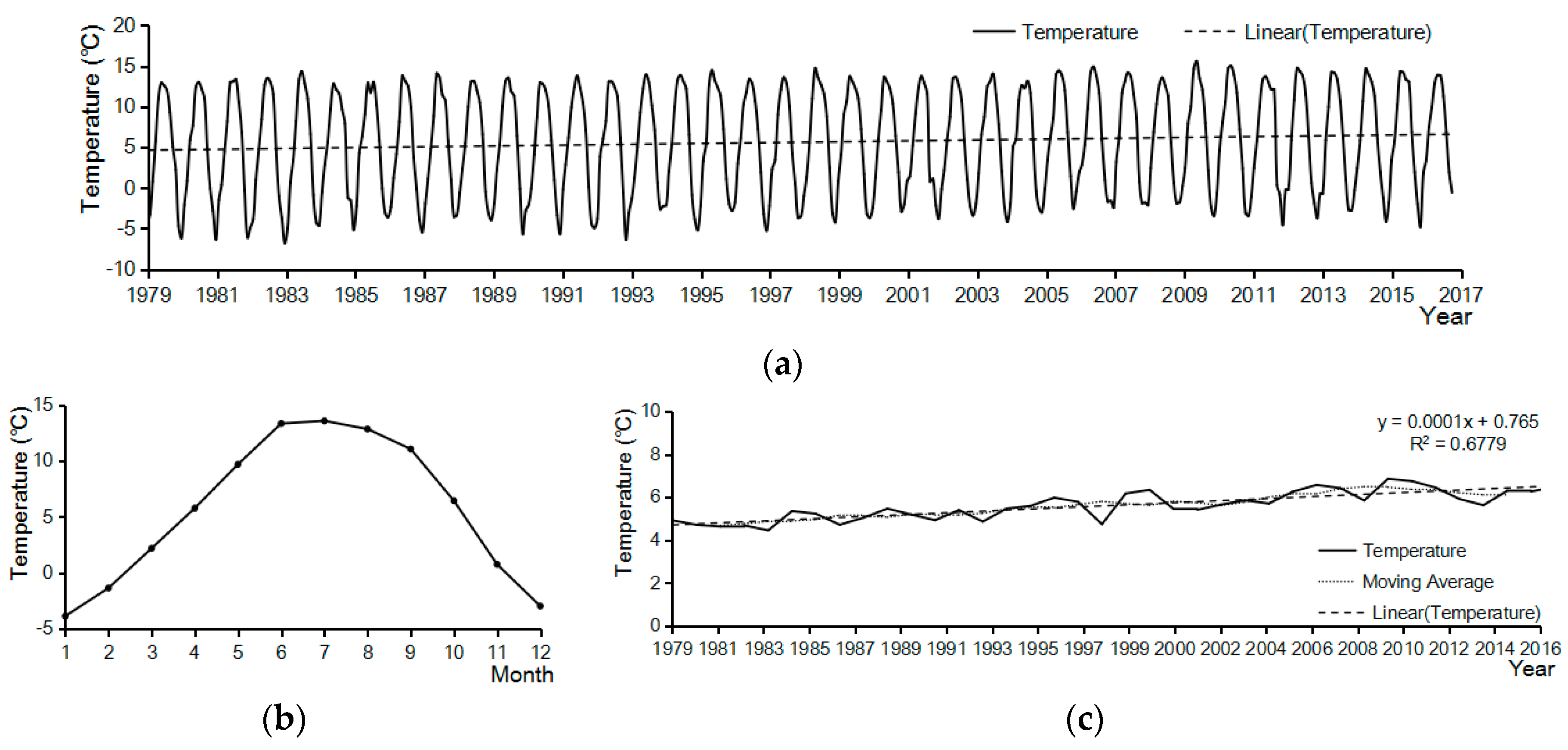


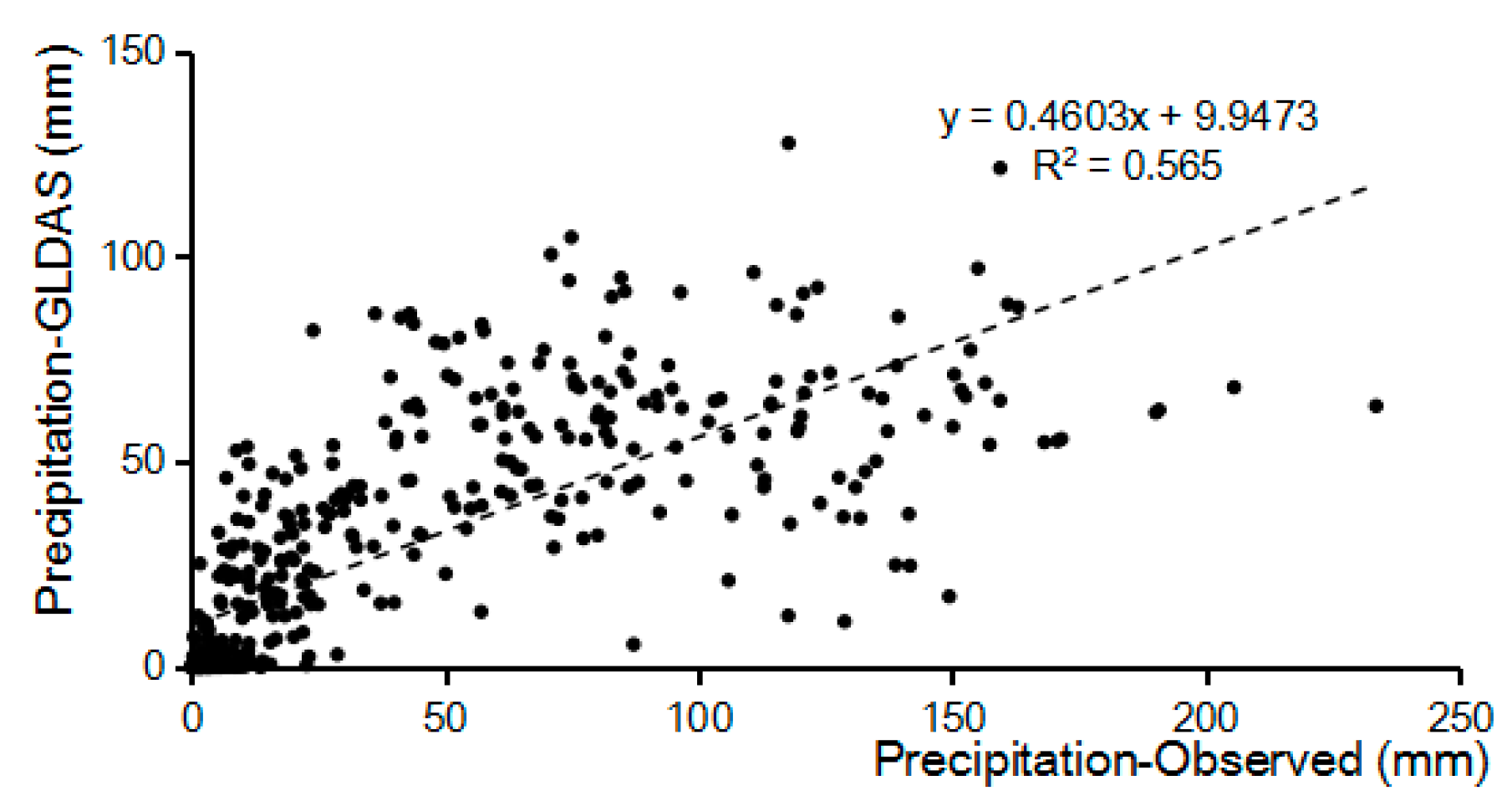



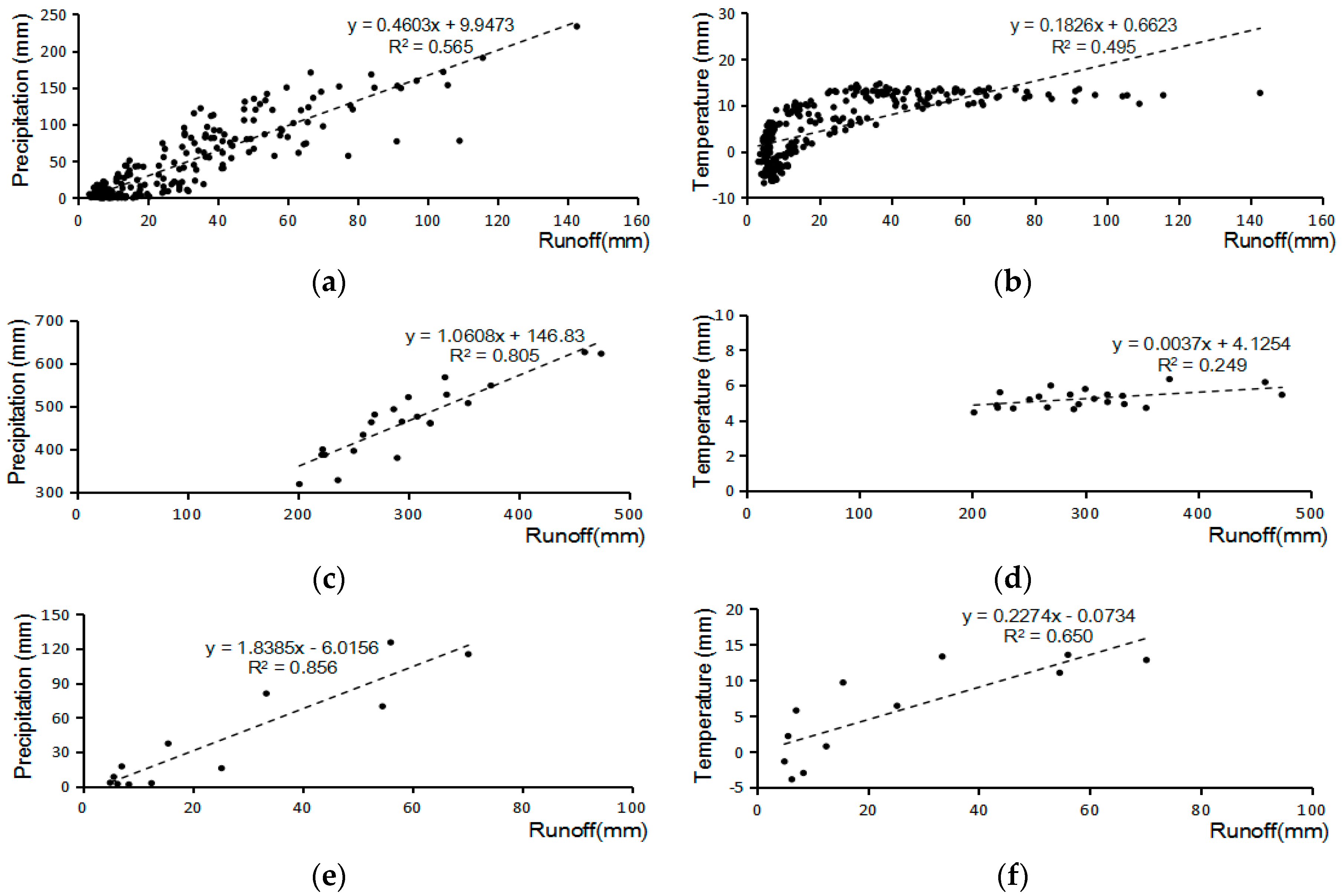
| Dataset | Amplitude (mm) | Cycle (month) | Phase (°) | Linear Trend (mm/a) |
|---|---|---|---|---|
| GLDAS-MOS | 91.91 | 12.00 | 146 | 0.44 |
| GLDAS-Noah | 67.11 | 12.01 | 108 | 0.33 |
| GLDAS-VIC | 77.92 | 11.99 | 151 | 0.26 |
| GLDAS-CLM | 83.19 | 12.00 | 107 | 0.11 |
| Observed runoff | 28.81 | 12.00 | 220 | 0.44 |
| Name | GLDAS-MOS | GLDAS-Noah | GLDAS-VIC | GLDAS-CLM |
|---|---|---|---|---|
| R | 0.70/3 | 0.74/1 | 0.69/4 | 0.70/2 |
| BIAS | 18.82/1 | 19.53/4 | 18.87/2 | 18.96/3 |
| σd | 26.13/3 | 21.41/1 | 23.53/2 | 30.92/4 |
| σr/σobs | 2.78/4 | 2.05/1 | 2.38/2 | 2.66/3 |
| Total ranking scores | 2.75 | 1.75 | 2.50 | 3.00 |
| Data | Correlation Coefficient between Precipitation and Runoff | Correlation Coefficient between Temperature and Runoff |
|---|---|---|
| Mean monthly values | 0.752 | 0.704 |
| Mean annual values | 0.897 | 0.499 |
| Secular mean monthly values | 0.925 | 0.806 |
© 2018 by the authors. Licensee MDPI, Basel, Switzerland. This article is an open access article distributed under the terms and conditions of the Creative Commons Attribution (CC BY) license (http://creativecommons.org/licenses/by/4.0/).
Share and Cite
Zhang, H.; Zhang, L.L.; Li, J.; An, R.D.; Deng, Y. Climate and Hydrological Change Characteristics and Applicability of GLDAS Data in the Yarlung Zangbo River Basin, China. Water 2018, 10, 254. https://doi.org/10.3390/w10030254
Zhang H, Zhang LL, Li J, An RD, Deng Y. Climate and Hydrological Change Characteristics and Applicability of GLDAS Data in the Yarlung Zangbo River Basin, China. Water. 2018; 10(3):254. https://doi.org/10.3390/w10030254
Chicago/Turabian StyleZhang, Hong, Ling Lei Zhang, Jia Li, Rui Dong An, and Yun Deng. 2018. "Climate and Hydrological Change Characteristics and Applicability of GLDAS Data in the Yarlung Zangbo River Basin, China" Water 10, no. 3: 254. https://doi.org/10.3390/w10030254




